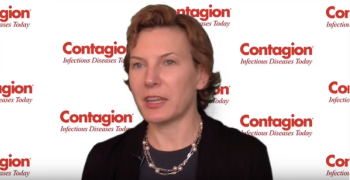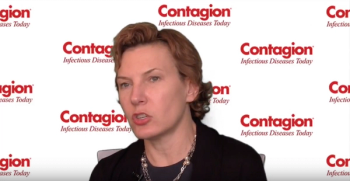
Non-sporicidal cleansers are commonly used to disinfect surfaces in the hospital rooms of patients with C auris colonization or infection, but are they efficacious?

Non-sporicidal cleansers are commonly used to disinfect surfaces in the hospital rooms of patients with C auris colonization or infection, but are they efficacious?

Investigators in New York state, which has the largest burden of C auris colonization in the US, used 12 point prevalence surveys at 6 nursing homes to identify 60 cases and 218 controls.

In a South Korean study of contaminated stethoscopes, 23% were confirmed to have at least 1 potential multidrug-resistant bacterial pathogen.

Julie Ann Justo, PharmD, MS, BCPS-AQ ID, provides examples from her institution about using prediction scores and rapid diagnostic scores in concert.

Barbara Wells Trautner, MD, PhD, explains the difference between asymptomatic bacteriuria and urinary tract infections.

Barbara Wells Trautner, MD, PhD, discusses finding alternatives to fluoroquinolones and facilitating patient communication to improve outcomes.

Barbara Wells Trautner, MD, PhD, discusses why physicians are using fluoroquinolones despite the FDA’s warning.

Barbara Wells Trautner, MD, PhD, explains the risk of aortic dissection and aneurysm in patients taking oral fluoroquinolones.

New software unveiled last month suggests hospitals could make patient-specific predictions of antibiotic susceptibility.

Julia E. Szymczak, PhD, shares the results of her study which revealed that fear drives some clinicians to prescribe inappropriately.

This emotional drive carried throughout the continuum of the prescribing pathway, from initial prescription to stopping or de-escalating antibiotics.

In case you missed them, we've compiled the top five infectious disease articles from this past week.

Dr. Gonzalo Bearman delves into the use of contact precautions for endemic pathogens such as MRSA and VRE and assesses the effectiveness of this approach.

If there are controlled substances at your facility, diversion is happening. What can be done to prevent future events?

Researchers present preliminary case series of confirmed cases of hepatitis A virus at Detroit Medical Center as Michigan struggles with ongoing outbreak.

According to recent research from Johns Hopkins Medicine, when it comes to making choices on appropriate antibiotic prescribing, outpatient providers are making the decision based on patient demand, not necessarily on what's actually appropriate for the condition.

Mike Kohut, PhD shares the results of his research that reveals providers are writing prescriptions for infections based largely on patient demand and not guideline recommendations.

Previously seen in Wisconsin in 2015-2016, Elizabethkingia seems to have made its way to the Empire state.

Emil Lesho, DO, FACP, FIDSA, FSHEA, explains what makes Elizabethkingia unique.

A recent survey explores prevention practices for Legionnaires’ disease and water management programs in health care facilities.

Dr. Thomas Sandora shares recent data on screening for asymptomatic carriage of Clostridium difficile and provides insight into what the preferred first-line treatment for the infection in children.

Contagion® Editorial Advisory Board member, James S. Lewis, PharmD, FIDSA, shares how antibiotic stewards can craft stewardship interventions to their own reality.

Kari Simonsen, MD, and Matthew Linam, MD debate the best way to measure and improve hand hygiene compliance.

In the SHEA Spring 2018 Opening Plenary, Zintars Beldavs stresses the importance of communication and collaboration in the fight against antimicrobial resistance.

Researchers compare CLABSIs attributed to CRE in short-term acute care hospitals with long-term acute care hospitals using data reported to NHSN in 2015-2016.

PIV infections are not as rigorously studied as CLABSIs, but they should be.

Contagion® will be covering the conference, and so, keep a look out for session coverage as well as interviews with some of the key presenters.

Daniel Diekema, MD, explains how clinicians can actively work to prevent pathogen spread in their health care facilities.

Michael Edmond, MD, MPH, MPA, stresses that a collaborative effort is needed to control C. difficile in hospitals.

Daniel Diekema, MD, describes recent developments made in rapid and molecular diagnostic testing in the microbiology lab, and how these tests strengthen infection prevention efforts.